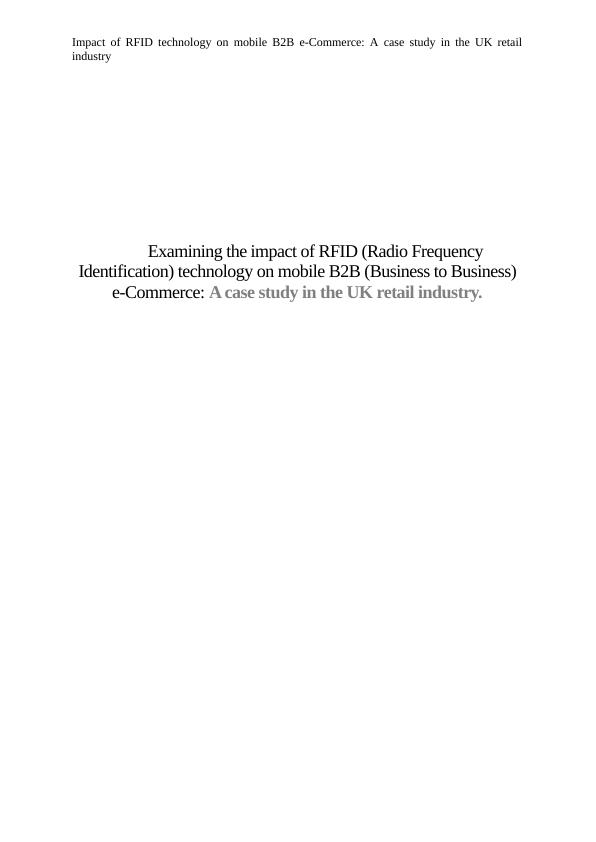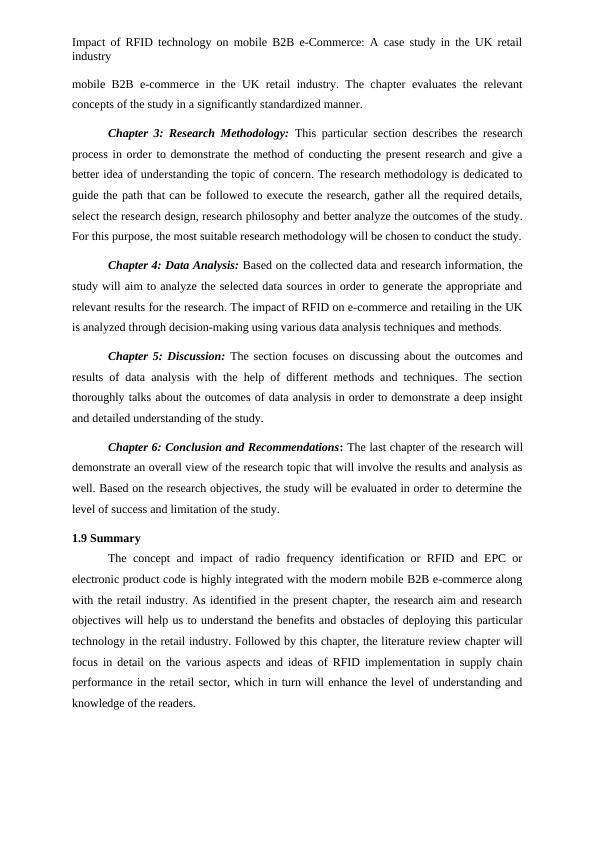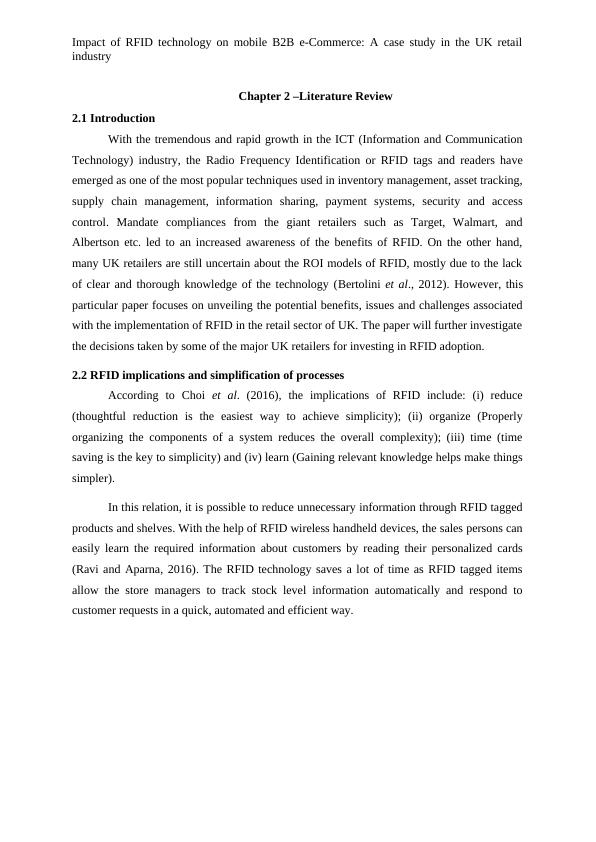Impact of RFID Technology on Mobile B2B e-Commerce: A Case Study in the UK Retail Industry
Write a 15,000-word research dissertation on Business Administration using IT/IS. The dissertation should include an abstract, acknowledgements, introduction, literature review, methodology, data analysis, discussion, and conclusion.
33 Pages9846 Words395 Views
Added on 2023-04-23
Impact of RFID Technology on Mobile B2B e-Commerce: A Case Study in the UK Retail Industry
Write a 15,000-word research dissertation on Business Administration using IT/IS. The dissertation should include an abstract, acknowledgements, introduction, literature review, methodology, data analysis, discussion, and conclusion.
Added on 2023-04-23
ShareRelated Documents
Impact of RFID technology on mobile B2B e-Commerce: A case study in the UK retail
industry
Examining the impact of RFID (Radio Frequency
Identification) technology on mobile B2B (Business to Business)
e-Commerce: A case study in the UK retail industry.
industry
Examining the impact of RFID (Radio Frequency
Identification) technology on mobile B2B (Business to Business)
e-Commerce: A case study in the UK retail industry.

Impact of RFID technology on mobile B2B e-Commerce: A case study in the UK retail
industry
Abstract
industry
Abstract

Impact of RFID technology on mobile B2B e-Commerce: A case study in the UK retail
industry
Acknowledgement
industry
Acknowledgement

Impact of RFID technology on mobile B2B e-Commerce: A case study in the UK retail
industry
Chapter 1 – Introduction
1.1 Introduction
The primary focus of the article this paper is to research, evaluate and understand the
impact of Radio Frequency Identification (RFID) technology on mobile Business to Business
(B2B) e-commerce and the supply chain performance of the retail industry of United
Kingdom. The study aims to improve the real understanding of how the RFID technology can
be applied in mobile e-commerce. The utilization of RFID technology has recently been
widespread among a number of large world leading retailers such as Target, Walmart, Tesco
and many more. Some of these giant retailers are highly engaged in the deployment of RFID
technology in order to accomplish various tasks related to retailing such as asset tracking
across their individual supply chains and so on (Asare et al., 2016). Thus, the paper aims to
unveil the emerging business as well as technological scenario resulting from the integration
of radio frequency and EPC or Electronic Product Code network along with its impact on
mobile B2B e-commerce.
1.2 Research Aim
The research aims to identify and investigate the impact of RFID technology on the
retail industry of UK including its effects on sales increase, stock availability as well as
overall supply chain performance. In order to achieve this purpose, the study will focus on
the use of RFID by the major retail companies in the UK, investigate how RFID technology
helps in real time inventory tracking, and supply chain performance management by studying
the retail systems of certain selected UK retailers. To be more precise, the paper will uncover
the major aspects of RFID use in order to understand the different benefits of RFID
implementation in B2B E-commerce.
1.3 Research Objectives
The research objectives for this study are formulated underneath:
To gain deeper insights into the implementation of RFID technology in e-commerce
and retailing
To identify the impact of RFID technology on mobile B2B e-commerce in the UK
retail sector
To evaluate the impact of integrating RFID-EPC network in supply chain
performance of UK retailers
industry
Chapter 1 – Introduction
1.1 Introduction
The primary focus of the article this paper is to research, evaluate and understand the
impact of Radio Frequency Identification (RFID) technology on mobile Business to Business
(B2B) e-commerce and the supply chain performance of the retail industry of United
Kingdom. The study aims to improve the real understanding of how the RFID technology can
be applied in mobile e-commerce. The utilization of RFID technology has recently been
widespread among a number of large world leading retailers such as Target, Walmart, Tesco
and many more. Some of these giant retailers are highly engaged in the deployment of RFID
technology in order to accomplish various tasks related to retailing such as asset tracking
across their individual supply chains and so on (Asare et al., 2016). Thus, the paper aims to
unveil the emerging business as well as technological scenario resulting from the integration
of radio frequency and EPC or Electronic Product Code network along with its impact on
mobile B2B e-commerce.
1.2 Research Aim
The research aims to identify and investigate the impact of RFID technology on the
retail industry of UK including its effects on sales increase, stock availability as well as
overall supply chain performance. In order to achieve this purpose, the study will focus on
the use of RFID by the major retail companies in the UK, investigate how RFID technology
helps in real time inventory tracking, and supply chain performance management by studying
the retail systems of certain selected UK retailers. To be more precise, the paper will uncover
the major aspects of RFID use in order to understand the different benefits of RFID
implementation in B2B E-commerce.
1.3 Research Objectives
The research objectives for this study are formulated underneath:
To gain deeper insights into the implementation of RFID technology in e-commerce
and retailing
To identify the impact of RFID technology on mobile B2B e-commerce in the UK
retail sector
To evaluate the impact of integrating RFID-EPC network in supply chain
performance of UK retailers

Impact of RFID technology on mobile B2B e-Commerce: A case study in the UK retail
industry
1.4 Background of the Topic
Even though the concept of radio frequency identification or RFID technology has
emerged very recently, its origin of application dates back to the World War II, when RFID
was used by British Air Force in order to distinguish allied aircrafts from enemy aircrafts.
There are multiple benefits of RFID implementation within the retail supply chain
management. According to Yükseland Yüksel (2011), the benefits and advantages of RFID,
application depends on the characteristics of the products that already exist. The basic
benefits involve increased product visibility, reduced shrinkage, and improved information
sharing as well as faster exception management. However, as per Fan et al., (2015), there are
a number of obstacles to the successful application of RFID technology in e-commerce. In
addition to that, from the consumer’s perspectives, it associates various costs and benefits of
the application and implementation of RFID in retailing. The integration of RFID-EPC
(electronic product code) has made it possible to highly optimize and automate the existing
business processes in the retail industry of UK (Ramanathan, Ramanathan and Ko, 2014).
Furthermore, the RFID technology extensively helps the UK retail companies in enhancing
the product availability.
1.5 Rationale of the Study
The RFID technology is highly useful in retail business management and the UK
retail sector is increasingly deploying the RFID-EPC technological inventions to optimize
their retail and supply chain operations across the different stages of business. However,
according to Fosso Wamba (2012), despite of the significant advantages and benefits of radio
frequency technology and EPC network in retail supply chain, the overall understanding of
the impact is potentially limited. Hence, the different utilization of RFID by some large UK
retailers will be investigated in this study in order to unveil the implementation optimizations.
The automated identification is potentially useful for managing the retail supply chain
performance in a more efficient manner. According to Bertolini et al., (2012), RFID
technology does not require line of sight sensors like barcodes. With the modern
technological advancement, the cost of RFID technology has significantly fallen. As a result,
the take-up rate by the UK retail sector has been significant due to the enhanced grip of
technology. It has potentially revolutionized the retailer’s control of the supply chain stages
of individual products and items as well as improved knowledge about the consumers.
1.6 Research Questions
The research questions for the present study have been demonstrated as follows:
industry
1.4 Background of the Topic
Even though the concept of radio frequency identification or RFID technology has
emerged very recently, its origin of application dates back to the World War II, when RFID
was used by British Air Force in order to distinguish allied aircrafts from enemy aircrafts.
There are multiple benefits of RFID implementation within the retail supply chain
management. According to Yükseland Yüksel (2011), the benefits and advantages of RFID,
application depends on the characteristics of the products that already exist. The basic
benefits involve increased product visibility, reduced shrinkage, and improved information
sharing as well as faster exception management. However, as per Fan et al., (2015), there are
a number of obstacles to the successful application of RFID technology in e-commerce. In
addition to that, from the consumer’s perspectives, it associates various costs and benefits of
the application and implementation of RFID in retailing. The integration of RFID-EPC
(electronic product code) has made it possible to highly optimize and automate the existing
business processes in the retail industry of UK (Ramanathan, Ramanathan and Ko, 2014).
Furthermore, the RFID technology extensively helps the UK retail companies in enhancing
the product availability.
1.5 Rationale of the Study
The RFID technology is highly useful in retail business management and the UK
retail sector is increasingly deploying the RFID-EPC technological inventions to optimize
their retail and supply chain operations across the different stages of business. However,
according to Fosso Wamba (2012), despite of the significant advantages and benefits of radio
frequency technology and EPC network in retail supply chain, the overall understanding of
the impact is potentially limited. Hence, the different utilization of RFID by some large UK
retailers will be investigated in this study in order to unveil the implementation optimizations.
The automated identification is potentially useful for managing the retail supply chain
performance in a more efficient manner. According to Bertolini et al., (2012), RFID
technology does not require line of sight sensors like barcodes. With the modern
technological advancement, the cost of RFID technology has significantly fallen. As a result,
the take-up rate by the UK retail sector has been significant due to the enhanced grip of
technology. It has potentially revolutionized the retailer’s control of the supply chain stages
of individual products and items as well as improved knowledge about the consumers.
1.6 Research Questions
The research questions for the present study have been demonstrated as follows:

Impact of RFID technology on mobile B2B e-Commerce: A case study in the UK retail
industry
How is RFID technology implemented in e-commerce and retailing?
What is the impact of RFID technology on mobile B2B e-commerce in the UK retail
sector?
What the impact of integrating RFID-EPC network in supply chain performance of
UK retailers?
Suggest adding a very short paragraph for each of these providing justifications and
reinforcing the importance.
1.7 Purpose of the Study
The primary purpose of the study is to identify the potential of RFID technology to
offer the UK retail sector a wide array of advantages and benefits throughout the supply chain
along with a higher level of management and control of the supply chain performances,
reduction in labor costs, reduction in shrinkage and improved customer experience. In
addition to that, the paper aims to study the major implications of RFID technology in order
to understand the pros and cons of implementing RFID-EPC in mobile B2B e-commerce in
terms of providing accurate, standardized and real time information (Vlachos, 2014). In the
UK retail industry, the radio waves in RFID technology is used to identify the individual
products and items that carry unique identification tags.
1.8 Structure of the Study
The study has been divided into multiple segments or chapters so that each of these
sections can highlight the research topic from different perspectives in a highly detailed
manner. Based on the particular chapter, the following aspects will be covered throughout the
study:
Chapter 1: Introduction: The basic details of the research study is described in this
section in such a way so that the readers can understand the purpose and rationale of
conducting the present study. Furthermore, the relevance of RFID technology in mobile e-
commerce and the retail industry is additionally discussed in a brief manner. In addition to
that, the research aim, research questions and research objectives further helps in better
implementation of the study and observation of results.
Chapter 2: Literature Review: This section comprises the fundamental theories,
concepts and ideas behind the research topic, which in turn will essentially help in
understanding the overall purpose and outcome of the research. In this section, the researcher
has tried to investigate and evaluate the overall concept of the impact of RFID technology in
industry
How is RFID technology implemented in e-commerce and retailing?
What is the impact of RFID technology on mobile B2B e-commerce in the UK retail
sector?
What the impact of integrating RFID-EPC network in supply chain performance of
UK retailers?
Suggest adding a very short paragraph for each of these providing justifications and
reinforcing the importance.
1.7 Purpose of the Study
The primary purpose of the study is to identify the potential of RFID technology to
offer the UK retail sector a wide array of advantages and benefits throughout the supply chain
along with a higher level of management and control of the supply chain performances,
reduction in labor costs, reduction in shrinkage and improved customer experience. In
addition to that, the paper aims to study the major implications of RFID technology in order
to understand the pros and cons of implementing RFID-EPC in mobile B2B e-commerce in
terms of providing accurate, standardized and real time information (Vlachos, 2014). In the
UK retail industry, the radio waves in RFID technology is used to identify the individual
products and items that carry unique identification tags.
1.8 Structure of the Study
The study has been divided into multiple segments or chapters so that each of these
sections can highlight the research topic from different perspectives in a highly detailed
manner. Based on the particular chapter, the following aspects will be covered throughout the
study:
Chapter 1: Introduction: The basic details of the research study is described in this
section in such a way so that the readers can understand the purpose and rationale of
conducting the present study. Furthermore, the relevance of RFID technology in mobile e-
commerce and the retail industry is additionally discussed in a brief manner. In addition to
that, the research aim, research questions and research objectives further helps in better
implementation of the study and observation of results.
Chapter 2: Literature Review: This section comprises the fundamental theories,
concepts and ideas behind the research topic, which in turn will essentially help in
understanding the overall purpose and outcome of the research. In this section, the researcher
has tried to investigate and evaluate the overall concept of the impact of RFID technology in

Impact of RFID technology on mobile B2B e-Commerce: A case study in the UK retail
industry
mobile B2B e-commerce in the UK retail industry. The chapter evaluates the relevant
concepts of the study in a significantly standardized manner.
Chapter 3: Research Methodology: This particular section describes the research
process in order to demonstrate the method of conducting the present research and give a
better idea of understanding the topic of concern. The research methodology is dedicated to
guide the path that can be followed to execute the research, gather all the required details,
select the research design, research philosophy and better analyze the outcomes of the study.
For this purpose, the most suitable research methodology will be chosen to conduct the study.
Chapter 4: Data Analysis: Based on the collected data and research information, the
study will aim to analyze the selected data sources in order to generate the appropriate and
relevant results for the research. The impact of RFID on e-commerce and retailing in the UK
is analyzed through decision-making using various data analysis techniques and methods.
Chapter 5: Discussion: The section focuses on discussing about the outcomes and
results of data analysis with the help of different methods and techniques. The section
thoroughly talks about the outcomes of data analysis in order to demonstrate a deep insight
and detailed understanding of the study.
Chapter 6: Conclusion and Recommendations: The last chapter of the research will
demonstrate an overall view of the research topic that will involve the results and analysis as
well. Based on the research objectives, the study will be evaluated in order to determine the
level of success and limitation of the study.
1.9 Summary
The concept and impact of radio frequency identification or RFID and EPC or
electronic product code is highly integrated with the modern mobile B2B e-commerce along
with the retail industry. As identified in the present chapter, the research aim and research
objectives will help us to understand the benefits and obstacles of deploying this particular
technology in the retail industry. Followed by this chapter, the literature review chapter will
focus in detail on the various aspects and ideas of RFID implementation in supply chain
performance in the retail sector, which in turn will enhance the level of understanding and
knowledge of the readers.
industry
mobile B2B e-commerce in the UK retail industry. The chapter evaluates the relevant
concepts of the study in a significantly standardized manner.
Chapter 3: Research Methodology: This particular section describes the research
process in order to demonstrate the method of conducting the present research and give a
better idea of understanding the topic of concern. The research methodology is dedicated to
guide the path that can be followed to execute the research, gather all the required details,
select the research design, research philosophy and better analyze the outcomes of the study.
For this purpose, the most suitable research methodology will be chosen to conduct the study.
Chapter 4: Data Analysis: Based on the collected data and research information, the
study will aim to analyze the selected data sources in order to generate the appropriate and
relevant results for the research. The impact of RFID on e-commerce and retailing in the UK
is analyzed through decision-making using various data analysis techniques and methods.
Chapter 5: Discussion: The section focuses on discussing about the outcomes and
results of data analysis with the help of different methods and techniques. The section
thoroughly talks about the outcomes of data analysis in order to demonstrate a deep insight
and detailed understanding of the study.
Chapter 6: Conclusion and Recommendations: The last chapter of the research will
demonstrate an overall view of the research topic that will involve the results and analysis as
well. Based on the research objectives, the study will be evaluated in order to determine the
level of success and limitation of the study.
1.9 Summary
The concept and impact of radio frequency identification or RFID and EPC or
electronic product code is highly integrated with the modern mobile B2B e-commerce along
with the retail industry. As identified in the present chapter, the research aim and research
objectives will help us to understand the benefits and obstacles of deploying this particular
technology in the retail industry. Followed by this chapter, the literature review chapter will
focus in detail on the various aspects and ideas of RFID implementation in supply chain
performance in the retail sector, which in turn will enhance the level of understanding and
knowledge of the readers.

Impact of RFID technology on mobile B2B e-Commerce: A case study in the UK retail
industry
Chapter 2 –Literature Review
2.1 Introduction
With the tremendous and rapid growth in the ICT (Information and Communication
Technology) industry, the Radio Frequency Identification or RFID tags and readers have
emerged as one of the most popular techniques used in inventory management, asset tracking,
supply chain management, information sharing, payment systems, security and access
control. Mandate compliances from the giant retailers such as Target, Walmart, and
Albertson etc. led to an increased awareness of the benefits of RFID. On the other hand,
many UK retailers are still uncertain about the ROI models of RFID, mostly due to the lack
of clear and thorough knowledge of the technology (Bertolini et al., 2012). However, this
particular paper focuses on unveiling the potential benefits, issues and challenges associated
with the implementation of RFID in the retail sector of UK. The paper will further investigate
the decisions taken by some of the major UK retailers for investing in RFID adoption.
2.2 RFID implications and simplification of processes
According to Choi et al. (2016), the implications of RFID include: (i) reduce
(thoughtful reduction is the easiest way to achieve simplicity); (ii) organize (Properly
organizing the components of a system reduces the overall complexity); (iii) time (time
saving is the key to simplicity) and (iv) learn (Gaining relevant knowledge helps make things
simpler).
In this relation, it is possible to reduce unnecessary information through RFID tagged
products and shelves. With the help of RFID wireless handheld devices, the sales persons can
easily learn the required information about customers by reading their personalized cards
(Ravi and Aparna, 2016). The RFID technology saves a lot of time as RFID tagged items
allow the store managers to track stock level information automatically and respond to
customer requests in a quick, automated and efficient way.
industry
Chapter 2 –Literature Review
2.1 Introduction
With the tremendous and rapid growth in the ICT (Information and Communication
Technology) industry, the Radio Frequency Identification or RFID tags and readers have
emerged as one of the most popular techniques used in inventory management, asset tracking,
supply chain management, information sharing, payment systems, security and access
control. Mandate compliances from the giant retailers such as Target, Walmart, and
Albertson etc. led to an increased awareness of the benefits of RFID. On the other hand,
many UK retailers are still uncertain about the ROI models of RFID, mostly due to the lack
of clear and thorough knowledge of the technology (Bertolini et al., 2012). However, this
particular paper focuses on unveiling the potential benefits, issues and challenges associated
with the implementation of RFID in the retail sector of UK. The paper will further investigate
the decisions taken by some of the major UK retailers for investing in RFID adoption.
2.2 RFID implications and simplification of processes
According to Choi et al. (2016), the implications of RFID include: (i) reduce
(thoughtful reduction is the easiest way to achieve simplicity); (ii) organize (Properly
organizing the components of a system reduces the overall complexity); (iii) time (time
saving is the key to simplicity) and (iv) learn (Gaining relevant knowledge helps make things
simpler).
In this relation, it is possible to reduce unnecessary information through RFID tagged
products and shelves. With the help of RFID wireless handheld devices, the sales persons can
easily learn the required information about customers by reading their personalized cards
(Ravi and Aparna, 2016). The RFID technology saves a lot of time as RFID tagged items
allow the store managers to track stock level information automatically and respond to
customer requests in a quick, automated and efficient way.

End of preview
Want to access all the pages? Upload your documents or become a member.
Related Documents
Importance of Radio Frequency Identification in Supply Chain and Logisticlg...
|14
|3573
|36
Radio-Frequency IDentification Report 2022lg...
|17
|3887
|19
RFID and Mobile Fusion for Authenticated ATM transactionlg...
|111
|27574
|62
Sensor Enabled RFID | Articlelg...
|11
|3030
|433
IMPACT OF RFID IN SUPPLY CHAIN MANAGEMENT IN ONLINE CLOTHINGlg...
|67
|17498
|40
Article Review on Use of RFID and GPSlg...
|5
|688
|13
